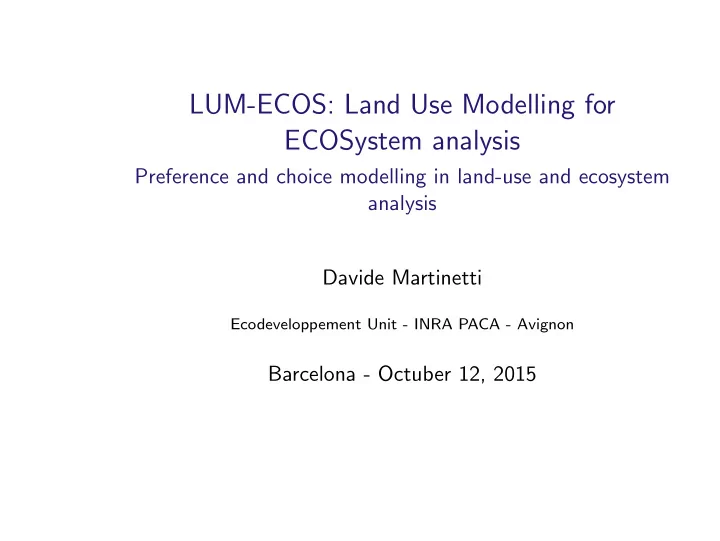

LUM-ECOS: Land Use Modelling for ECOSystem analysis Preference and choice modelling in land-use and ecosystem analysis Davide Martinetti Ecodeveloppement Unit - INRA PACA - Avignon Barcelona - Octuber 12, 2015
Objective of the project Understanding the link between land-use and the presence/dissemination of micro-organisms in the atmosphere. Facts: ◮ Many types of microorganisms circulate in the atmosphere via clouds and precipitation; ◮ Land use influences the concentration and vertical flux of MO’s at ground level; ◮ Airborne MO’s can be pathogens and have an impact on the climate via bio-precipitation. 2 / 11
Land use effects on MO concentration and flux The land cover is key for quantifying the concentration and ver- tical flux of MO in the atmosphere ◮ presence of tree canopies ◮ crop ◮ forest ◮ grassland ◮ etc. ◮ physical characteristics ◮ altitude, temperature and solar exposition ◮ humidity and presence of water ◮ rain and seasonal effects ◮ etc. ◮ human-driven effects ◮ high density population ◮ industry/pollution ◮ agricultural practices ◮ etc. 3 / 11
Estimated MO’s concentration 1 Ecosystem Best estimate Low estimate High estimate 7 . 6 × 10 4 2 . 3 × 10 4 1 . 3 × 10 5 coastal 1 . 1 × 10 5 4 . 1 × 10 4 1 . 7 × 10 5 crops 1 . 6 × 10 2 3 . 8 × 10 4 deserts 5 . 6 × 10 4 3 . 3 × 10 4 8 . 8 × 10 4 forests 1 . 1 × 10 5 2 . 5 × 10 4 8 . 4 × 10 5 grasslands 1 × 10 4 land ice 1 × 10 4 1 × 10 1 8 × 10 4 seas 3 . 5 × 10 5 1 . 2 × 10 4 8 . 4 × 10 5 shrubs 1 . 2 × 10 4 5 . 6 × 10 4 tundra 9 × 10 4 2 × 10 4 8 × 10 5 wetlands 6 . 5 × 10 5 4 . 4 × 10 5 9 . 2 × 10 5 urban 1 . 2 × 10 5 4 . 8 × 10 4 1 . 9 × 10 5 urban park Table: Estimates of total mean bacterial concentration in near-surface air of various ecosystem types (units per m3) 1 Burrows et al. Bacteria in the global atmosphere. Atmos. Chem. Phys. 2009. 4 / 11
Land Use Modelling - LUM Land Use modelling is used in our project to forecast land use changes in the middle term (10-15 years) in the PACA region. 5 / 11
LUM in PACA We have access to a huge database ( > 4 million observations) at parcel-level scale, with socio-economic, geographical and agricul- tural explanatory variables. The LUM aims to explain the land use in each parcel according to the observed features. For this part we intend using a Spatial Autoregressive Probit model. Th advantage of this model is that it takes into account the spatial dependence between neighbouring parcels. 6 / 11
LUM - Spatial Dependence 7 / 11
ECOS - Diffusion of MO’s and their potential effect Once the MO enter the atmosphere they follow the air current and can travel several hundreds of kilometers afar. The objective of this part of the project is to simulate the diffusion patterns according to changing land-use scenarios. 8 / 11
Effects of MO on the Ecosystem Part of the MO that entered the atmosphere will precipitate somewhere, causing potential infection at destination point. In our study we consider the bacteria Pseudomonas Syringae , responsible of the majority of frost damage in plants. 9 / 11
Effects of MO on the Ecosystem Others stay in the air and can help the formation of clouds and precipitation, a phenomenon called bio-precipitation. Again, the Pseudomonas Syringae is of particular interest, since it has ice-nucleation properties. 10 / 11
Farewell For more informations, contact me during the poster section! Thanks for your attention. 11 / 11
Recommend
More recommend